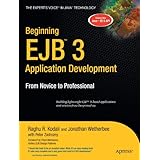
Average Reviews:

(More customer reviews)Are you looking to buy Beginning EJB 3 Application Development: From Novice to Professional (Beginning: From Novice to Professional)? Here is the right place to find the great deals. we can offer discounts of up to 90% on Beginning EJB 3 Application Development: From Novice to Professional (Beginning: From Novice to Professional). Check out the link below:
>> Click Here to See Compare Prices and Get the Best Offers
Beginning EJB 3 Application Development: From Novice to Professional (Beginning: From Novice to Professional) ReviewThis book is targeted at developers who are experienced with Java and have built multi-tier applications using earlier versions of EJB. In order to work out the examples in this book, you should be very proficient in using the command line and/or Ant. Working knowledge of the GlassFish application server is also needed.If you have already worked with the previous versions of the EJB specifications and want to migrate to EJB3 - or even just want to find out how it works - this will be the perfect guide for you. The examples throughout the book should give the reader a very good understanding of EJB3. It should be easy to migrate your earlier versions of EJB applications to EJB3 with this book in your library.
The only issue I had with the book was with the build files (Ant scripts) provided. I have been using Ant for several years and didn't feel they were up to the level of the rest of the book. For example, the book suggests you set an environment variable for GLASSFISH_HOME, but this value isn't used in the build files: instead, a property is set in the properties file for chapter 1. If you skip reading the readme file (and who doesn't?), you will spend a lot of time probing what went wrong before you find it.
Once you finish reading this book, you will agree with me that the new EJB 3 specification (JSR-220) offers great improvements over the earlier EJB versions in terms of simplifying development, adding new features, facilitating test-driven development, and focusing more on POJOs rather than on complex APIs.
While the material covered in this book is outstanding, there are more mistakes than I would expect in the samples. On the other hand, the authors do have a link on the Apress web site for corrections. While working on the examples, I recommend you have a printed copy of these corrections. I would recommend this book to developers who want to migrate to EJB3 or those who want to build applications using this new simplified EJB3 architecture.
With EJB 3 gaining momentum, there are a number of books now available in the market. I read two of the books "Beginning EJB(tm) 3 Application Development: From Novice to Professional" from Apress and "Enterprise Java Beans 3.0, Fifth Edition"from O'Reilly.
If you have had previous experience with earlier versions of the EJB specification, or plan to migrate to the new spec, then the book "Beginning EJB(tm) 3 Application Development: From Novice to Professional" would be an excellent choice. On the other hand, if you would like to see what EJB 3.0 offers, "Enterprise Java Beans 3.0, Fifth Edition" sets the standard.
If technical material is of great importance, both books provide this equally well. However "Enterprise Java Beans 3.0, Fifth Edition " gets a little tedious if you continue reading for a long time when compared to "Beginning EJB(tm) 3 Application Development: From Novice to Professional". In contrast, if you want good working examples then I would suggest you look at "Enterprise Java Beans 3.0, Fifth Edition".
In conclusion, both books have some strong and weak points, get a book buddy or your colleague and buy both of them. That way, you get the benefits of both books.
Beginning EJB 3 Application Development: From Novice to Professional (Beginning: From Novice to Professional) OverviewEnterprise JavaBeans 3.0 (EJB 3.0) is a vital component of Sun's new lightweight Java Enterprise Edition 5 platform (Java EE 5). They are used for the development and deployment of component-based enterprise business applications such as transaction-based applications.Ever since its first release, EJB has been the subject of much media attention and no little controversy. EJBs represent a sophisticated and powerful technology and EJB-based applications can support high numbers of transactions and users, with maximum security. However, previous incarnations of EJB have come to be regarded by many as an overly complex technology that can lead to costly and time-consuming solutions that are difficult to build, implement and maintain.The new lightweight EJB 3 is set to change all that. It has made huge advances in ease of development, and its drastically simplified programming model has been widely acclaimed and embraced. Beginning EJB 3 takes the reader through the details of the EJB 3.0 architecture, and shows how EJB can be used to develop powerful, standards-based backend business logic.With 12 years of combined EJB experience, the authors offer many practical insights into the entire EJB architecture, covering all areas of the EJB 3.0 specification, including its new persistence framework, simplified development model, and other key new features.
Want to learn more information about Beginning EJB 3 Application Development: From Novice to Professional (Beginning: From Novice to Professional)?
>> Click Here to See All Customer Reviews & Ratings Now
0 comments:
Post a Comment